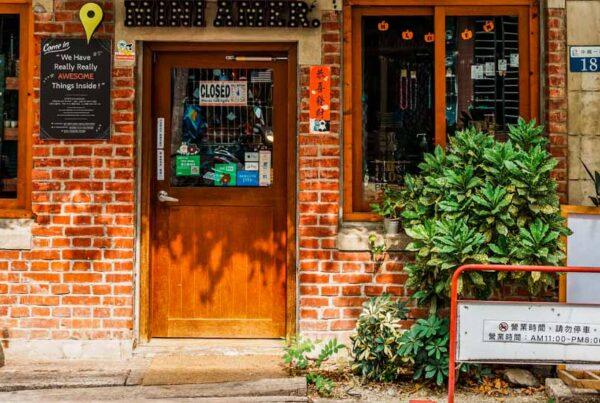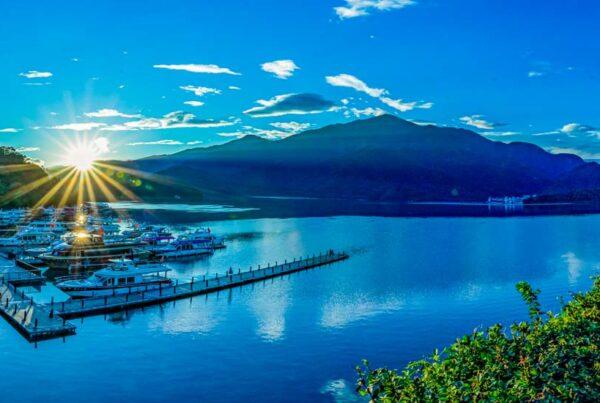A Fun-Filled 4-Day Journey in the South of Taiwan
TEXT / TWELLI
PHOTOS / TWELLI, VISION
Alishan and Kenting are two of the top-tourist draws in Taiwan. One is known for high mountains with coniferous forests, bamboo groves, tea plantations, indigenous villages, and a narrow-gauge alpine railway line, the other is the island’s most popular tropical beach resort location with fine-sand beaches, coral reefs, and plenty of outdoor fun. These two popular national forest recreation areas could not be more different from each other, but as you will find out below, you can easily combine visiting both during a short trip down south.
For this trip, which covered such large and far-flung destinations, we decided to set up a ‘dueling writers’ scenario, with two of our reporter-travelers heading out with the same group. Check out Rick Charette’s file, The ALISHAN and KENTING National Forest Recreation Areas, for his take on the trip’s myriad different sights and experiences.
During my almost 30 years living in Taiwan, I have been to quite a few of the island’s national forest recreation areas. Let’s see… Alishan, Aowanda, Fuyuan, Guanwu, Hehuanshan, Kenting, Manyueyuan, Neidong, Taipingshan, Wuling, and Zhiben. That’s 11 out of 18. Not bad, and hopefully I will have the chance to visit the remaining seven as well some day, because I really, really love going to the forest!
(Learn more about all these areas here.)

Alishan and Kenting are familiar names among the must-see tourist destinations in Taiwan. The two forest recreation areas are part of larger entities of the same name; the first is within the Alishan National Scenic Area, the latter within the Kenting National Park. Both offer an amazing richness of ecological resources, unique flora and fauna, well maintained trails, bilingual signage and information boards, and scenic attractions galore.
While I had visited Alishan and Kenting before, I was still very excited when I was invited to go on this trip arranged by the Forestry Bureau in late October. There would still be a number of “firsts” for me, some highly anticipated, others rather unsuspected. I was eagerly looking forward to take, for the first time, the Alishan Forest Railway, which transports travelers from low-altitude Chiayi City to the high-altitude Alishan area. I also could not wait to do sea kayaking, another first for me. What I did not expect was encountering amazing wildlife, hanging from a giant tree, and visiting a “fairy cave.” I also wasn’t prepared for the warm reception and the passionate sharing of information by the local guides we met in the forest recreation areas.
Alishan Forest Railway
Based in Taipei City in the north of Taiwan, the first part of my and some of my fellow travelers’ journey was getting down to Chiayi City in the south to catch the 9 o’clock train bound for Alishan. Luckily, the Taiwan High Speed Rail bullet trains take you down to south Taiwan in no time (I took the 6:30am train and arrived at 7:40). After meeting up with the other tour participants and the tour leaders we took the bus to Chiayi Railway Station.
Currently, the forest railway operates between this station and the tiny station of Shizilu in the Alishan area. From there, you have to take a bus further uphill to reach the national forest recreation area. After the line was severely damaged during typhoon Morakot in 2009 it was temporarily shut down, save for the trains running inside the forest recreation area. The project of restoring the railway in its entirety has been a difficult one, but step by step, the line has been revived. At the end of 2012, trains started to roll again between Chiayi and Zhuqi; in early 2014, the stretch from Zhuqi all the way up to Fenqihu was reopened; and in July of 2017 two more stations were put back into business, the last being Shizilu. Plans are to have the complete line restored by 2022.

| Some facts and useful info about the Alishan Forest Railway – The railway line project was started in 1906 during the Japanese colonial era; the first section between Chiayi and Zhuqi was completed in 1908; in 1912 the line was extended to Erwanping, and in 1914 it reached Zhaoping. Many decades later the railway became a tourist attraction. In 1983 the 9.2km Minyue branch line to Shihou Station and in 1986 the 6.25km line to Zhushan Station (close to the sunrise viewing platform) were established. – Today, there are 20 stations in total: Chiayi (30m) – Beimen (31m) – Lumachan (82m) – Zhuqi (127m) – Mululiao (324m) – Zhangnaoliao (543m) – Dulishan (743m) – Liyuanliao (904m) – Jiaoliping (997m) – Shuisheliao (1,186m) – Fenqihu (1,403m) – Duolin (1,516m) – Shizilu (1,534m) – Pingzhena (1,711m) – Erwanping (2,000m) – Shenmu (2,138m) – Alishan (2,216m) – Zhaoping (2,274m) – Duigaoyue (2,405m) – Zhushan (2,451m) – The total length of the line is 71.4km and it has 47 tunnels and 72 bridges. – On weekdays the train departs from Chiayi at 9am (on weekends and holidays at 8:30am [to Fenqihu] and 9:30am [to Shizilu]); from Shizilu the train departs for the trip back to Chiayi City at 1:50pm (on weekends and holidays at 1pm). – The train ride from Chiayi to Shizilu takes about 3 hours. – Tickets are priced NT$459 one way. For more information, visit the bilingual Alishan Forest Railway and Cultural Heritage Office website. |


The first thing I noticed after boarding the train was how narrow the cars are inside, it’s a narrow-gauge railway after all, and the train shakes quite a bit during the ride. But it’s a whole lot of fun. The most interesting part of the journey is looking out the window and witnessing how the scenery changes, dramatically. The busy city streets of Chiayi soon give way to rural countryside, still on the plain. Then the train, slowly but surely, makes its way uphill. You will see forests getting denser and valleys, on both sides of the train, getting deeper. You’ll pass many a bamboo grove and the occasional tea plantation as well.
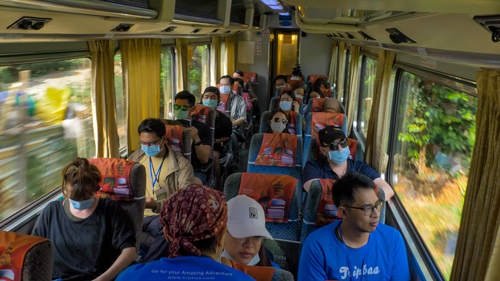

Most of the stations along the line are rather tiny, with the exception of Fenqihu, a village popular with tourists. Unfortunately the train only stops very briefly at each station, and there is usually no time to go outside and take photos. Luckily, however, I was granted permission by the conductor to dash out a few times to get some quick shots at some of the stops. Interestingly, there are no platforms at the smaller stations, only metal stairs, placed along the rails, one for each door of the train.


There are many fascinating facts and stories about this amazing engineering feat of a railway line. Thanks to our friendly and knowledgeable guide, Ms. Liu Shu-min, who accompanied us during the train ride, we learned a lot about the history of the railway and the area the train traverses. Since we have a host of other highlights from this trip to cover, however, I will leave a more in-depth introduction of the line for another time.
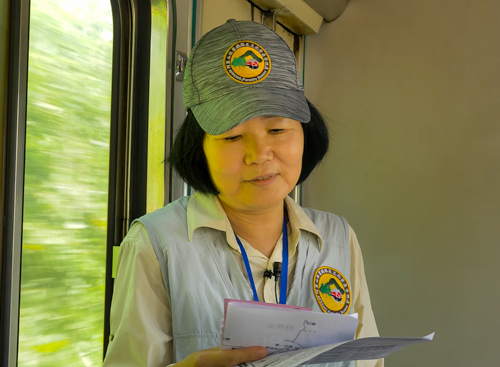
We got off the train at Shizilu and did not have to walk far to get to the restaurant (right by the railway tracks where the train stops) where we would enjoy the first meal of this trip. (A big thanks to the tour organizers for not only putting together a rich itinerary with one interesting place to visit after another, but also for taking us to some fine restaurants that collectively presented a rich range of culinary options available in Taiwan.)
The restaurant, MX Café, was opened not long after Shizilu had become a working station once again and tourists started to arrive by train. We had a hearty meal of tender-chicken noodle soup plus aromatic coffee made with beans sourced in the Alishan area (highly recommended). Since the train is parked at Shizilu waiting for the trip back down to Chiayi City in the afternoon, this stop is also the perfect location for taking pictures of the bright-red locomotive and orange-yellow carriages.





Shizilu literally means “intersection” or “crossroads” and the reason for that is that it is the station closest to the main highway (No. 18) through the Alishan National Scenic Area. This proximity makes it easy for tourists arriving by train to continue their journey by bus. After walking downhill from the station to the highway, you can’t miss the bus stop of the Taiwan Tourist Shuttle network’s Alishan Route, which connects Chiayi City with the forest recreation area.
Alishan National Forest Recreation Area
Since this was an organized trip, we didn’t have to wait for the tourist shuttle. Our tour bus was already waiting to take us further uphill. From Shizilu it takes less than half an hour to get to the Alishan National Forest Recreation Area. You enter through a large gate where you have to pay admission (NT$300/adults); next you will come to a large parking lot with shops, eateries, and a visitor center providing you with all the information you might need to explore the area. A bit further uphill you will see the Alishan Railway Station from where you can take trains that operate within the forest recreation area.
Private vehicles and tour buses are not permitted past the parking lot, and getting to our hotel, the Alishan House, required us to switch to mini shuttle buses. Alishan House is a hotel with a long history and a superb location, smack in the center of the forest recreation area. Step out of the hotel and you are just a short walk away from the network of easy-to-follow trails through refreshing tall-tree forest. During sakura season (March~April) you can enjoy the mesmerizing splendor of pink petals right outside the hotel.
Book a room here.
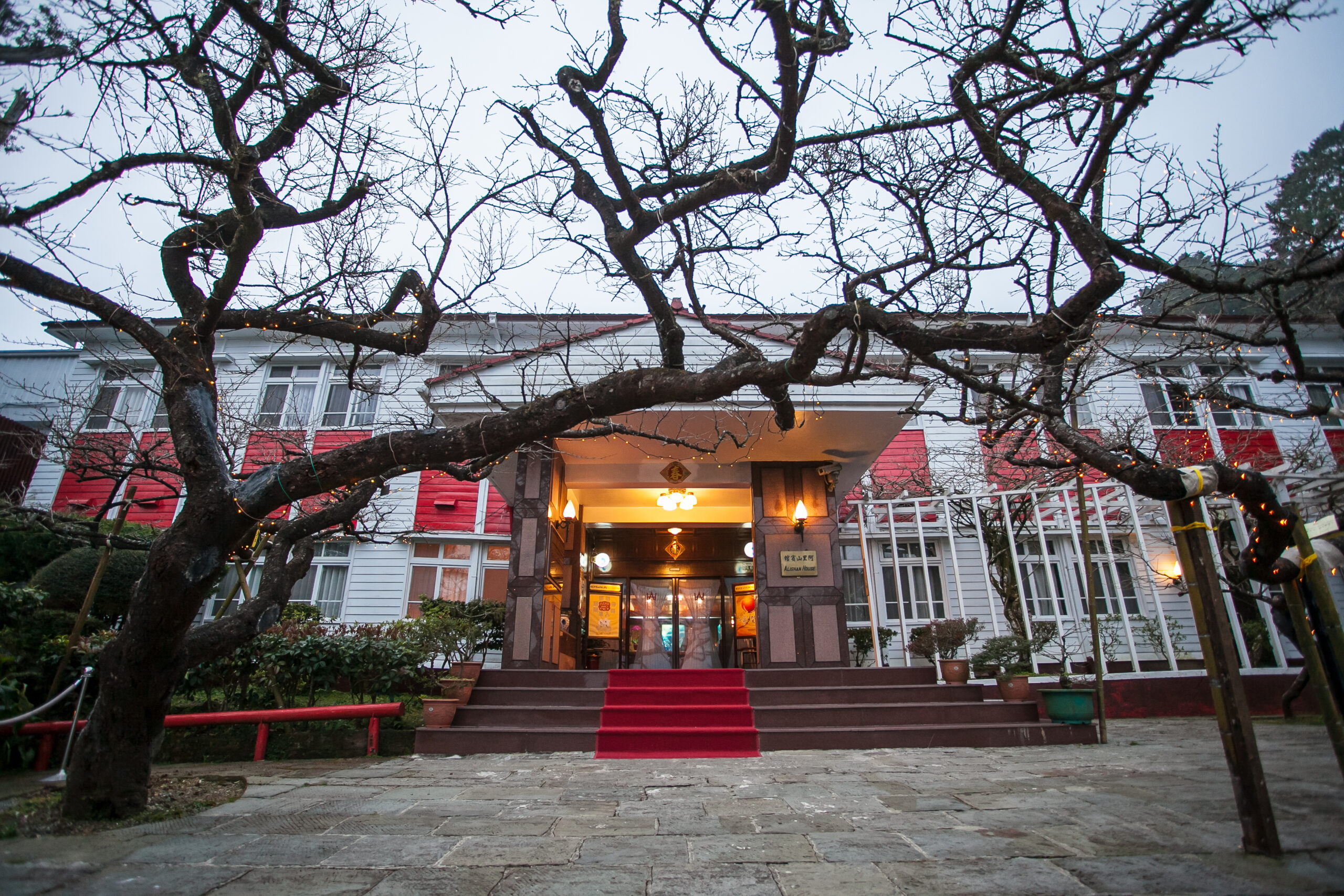
After leaving our luggage at Alishan House, we went on a guided tour of the main parts of the recreation area. For obvious reasons, it is much quieter this year without foreign and mainland China tourists who used to come in large numbers to this top Taiwan tourist destination. There are impressive tree trunks to observe, some hollowed out, so that you can almost walk through them. Perhaps the most iconic sight in the forest is a pair of ponds named Sister Ponds, the larger of which has a thatched-roof pavilion in its center. Surrounding the lakes you will find many Taiwan red cypress trees. Planted by the Japanese in 1930, this is the densest concentration of these trees in the national scenic area.



Towards the end of the tour, our local guide, Mr. Huang Lian-hai, approached me and showed me a picture on his cell phone, while pointing at Shouzhen Temple, the most important place of worship in the forest recreation area. “Did you know that once each year, these owl moths will gather in the temple and sit on the statue of Mazu?” “I didn’t know that! These moths are really beautiful!” “The temple is known to answer the prayers of the faithful.” You always learn something new; one of the great takeaways of this trip.

Alishan Sunrise
The next day we did what most tourists who stay overnight inside the forest recreation area will do: taking the pre-dawn train to Zhushan Station, then walking to the Mt. Ogasawara lookout platform and watch the sunrise over Mt. Jade (Yushan), Taiwan’s highest mountain. The 5 o’clock train, departing from Alishan Station, was packed, everyone in great spirits and full of expectation.
| Alishan Sunrise Train Info Since the time of the sunrise varies according to the time of year (7am in early January, 5:20am in June), the schedule for trains departing Alishan Station for Zhushan Station changes from day to day. The times are announced the day prior at around 4:30pm on the official website, at Alishan Station, the recreation area’s entrance, and the visitor center. The number of passengers each morning is limited to 700 (weekdays) and 1,000 (holidays and weekends). Tickets (NT$120) need to be bought in advance online or at one of the main stations of the Alishan Forest Railway. |


Zhushan Station, the line’s terminal station, currently being remodeled, everyone had to get off the train at the penultimate stop, Duigaoyue, and walk from there for about 40 minutes to the sunrise view location. A sizable crowd had already gathered when we arrived and everyone was marveling at the “sea of clouds” that had formed in a deep valley seen below from the observation platform. The sunrise did not disappoint either, pictures were taken, everyone was excited.



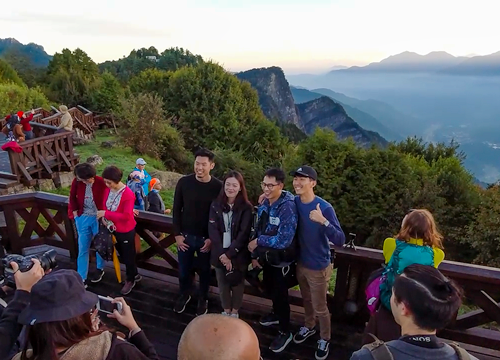
While I had seen the sunrise before, I was not aware that there is another attraction close by. Our passionate and caring tour guide for the whole trip, Moon Liu, took us a bit further south from the sunrise view platform. “Let’s see the mikado pheasant!” This type of bird being notoriously elusive, I was doubtful of the chance to see one, especially considering the many tourists gathering here at this time of the day. But no, there it was, feeding peacefully, not far from the boardwalk, oblivious of the people snapping pictures. I waited my turn. Actually I waited until everyone had left. The bird started to come closer and I was able to take pictures of it walking past me just two meters or so away.

Note: If you don’t know what a mikado pheasant looks like, take out a NT$1,000 bill; the pheasant is on the backside.

Before reaching the sunrise viewing platform on your way from the railway station you will pass a wooden building on the right-hand side. This is the Mountain Ali Tea No. 35 teahouse, a great place to have a simple breakfast, which includes excellent high-mountain tea (Oolung and black tea) produced in the Alishan region. Adjacent to the teahouse is a high-mountain botanical garden perfect for a relaxed early morning stroll. There, I spotted quite a few interestingly looking birds frolicking in the trees. Btw. if you have breakfast on the terrace of the teahouse, be aware of the white-whiskered laughingthrushes trying to get close to your table. I left my seat for just a few seconds and one of them had already stolen a raisin from my plate…



More articles about Alishan
ALISHAN — Tea and Coffee
Beautiful Scenery in Northern ALISHAN
Southern ALISHAN — Shanmei, Xinmei, and Chashan
Chiayi City Railway Park
After returning to Chiayi City we visited the area around Beimen Station, the second stop on the Alishan Forest Railway Line. If you are interested in history and railways, this is the perfect playground for you. A local guide, Mr. He Sheng-jie, showed us around the Chiayi Lumber Factory and the Alishan Forest Railway Garage Park, where you can learn about the history of logging in southern Taiwan and have a close look at a number of decommissioned locomotives and train cars on display.



There are many old Japanese-style buildings, in this part of town, including the greenish-blue Beimen Station, that are perfect for taking pictures with a touch of nostalgia. Hinoki Village, not far from the station, is a cluster of dark-brown Japanese-era wood buildings housing gift shops and eateries. I couldn’t resist and treated myself to a large roast-tea-flavored ice-cream wrapped inside a waffle and topped with sweet mochi balls. Super sinful delicious!


More articles about Chiayi
Things to Do in CHIAYI COUNTY
MEISHAN Township in CHIAYI County
Old Neighborhoods in CHIAYI
Kaohsiung Overnight Stay
Next, we headed south. For the second night we stayed at a hotel with a superb location. The City Suites is right beside Kaohsiung harbor, close to the well-known Pier-2 Art Center (art and entertainment), the Dayi Pier-2 LRT Station (convenient public transport to other parts of the city), and the Dagang Bridge. Cross this footbridge and you come to the Banana Pier and the Kaohsiung Port Warehouse No. 2 (KW2) shopping and dining complex from where you can take the ferry to Qijin Island. If you look for a hotel in Kaohsiung that is conveniently located, make it the City Suites! Weather permitting you’ll even be able to see a gorgeous sunset from your guestroom (provided you stay on one of the upper floors in a room that faces the harbor).
Book a room here.

Houwan Tofu and Sea Salt Experience
On the third day of our fun-packed journey down south we made our way to the southernmost part of Taiwan, the Hengchun Peninsula. The main highway (No. 1) hugs the coast and the further south you get, the stronger the tropical vibe becomes. Palm trees, sandy and rocky beaches, and a vibrant turquoise sea is what you’ll see to your right while making your way south along the west side of the peninsula. Southwest of Checheng town we arrived at the tiny fishing village of Houwan, sitting at the southern end of a crescent-shaped bay. On the northern end you will notice the modern National Museum of Marine Biology and Aquarium. While most visitors come to Houwan to check out the marine life displayed inside that museum, we were here for something a bit more exciting, sea kayaking!
Did you know that you can stay overnight in the museum, sleeping right by the aquarium?

But before heading to the sea to tackle the white-capped water stirred up by strong winds, we first filed into a much more peaceful location. Hidden behind a thick wall of coastal forest along the highway is the An Jia Chun Eco Leisure Village, a small compound of old houses and an open workshop area where you can learn about the process of making salt from seawater, and making tofu with bittern. Sea salt production has a long tradition in Houwan; in the past the local residents used to take advantage of the coral reef rocks along the coast to collect salty sea water. In charge of the tofu making operation is Sister Heimao (Black Cat), a retired dance teacher who is now dedicated to the preservation of local traditions, including making sea salt and tofu the old-fashioned way. She has also been heavily involved in activities to protect the local natural environment.


You will learn a lot about salt and tofu in a 3-hour session offered at An Jia Chun (prior group reservation required). I was amazed at seeing how saltwater turned into pure salt after constant frying in a large wok over a wood fire. The tofu products, including watery tofu, tofu pudding, and firm tofu, that were prepared for us had a distinct natural and smoky flavor and, combined with spicy pickled radish, were extremely tasty.
Sea Kayaking
Next up was the sea kayaking. From the bus, while approaching Houwan, we had already noticed the strong winds sweeping across the waters of the Taiwan Strait, whipping up the waves, and we started wondering whether going out on a kayak was even possible on this day. Arriving at the kayaking operation of the Houwan Community, we were assured by the instructor that there was nothing to worry about. Signing a waiver, in case something bad would happen, was still required, though….
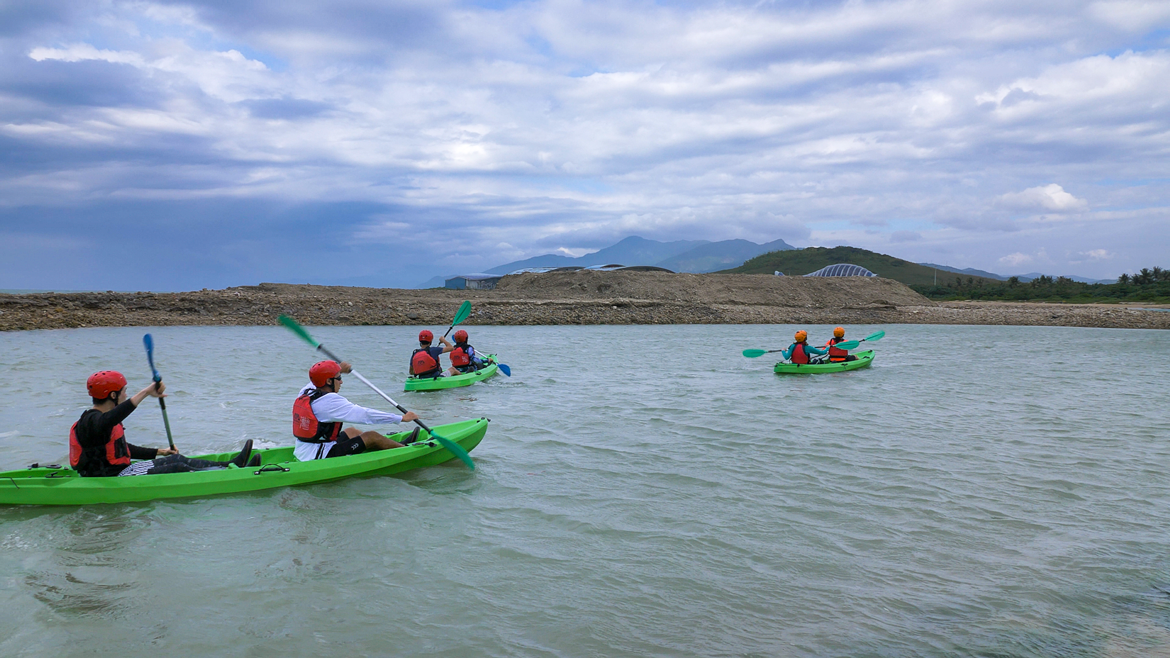
After receiving the mandatory instructions on land, we moved to a small dike-protected area of Houwan Bay where it was safe to launch our two-seater kayaks. We had done kayaking before but not in this kind of windy conditions. Surprisingly, though, it was quite easy to paddle towards the center of the bay and then further on to a tiny beach close to the aforementioned marine biology museum. There, we received more instructions, this time standing in the pleasantly warm water. We learned what to do when your kayak capsizes, which would come in handy just a few minutes later.
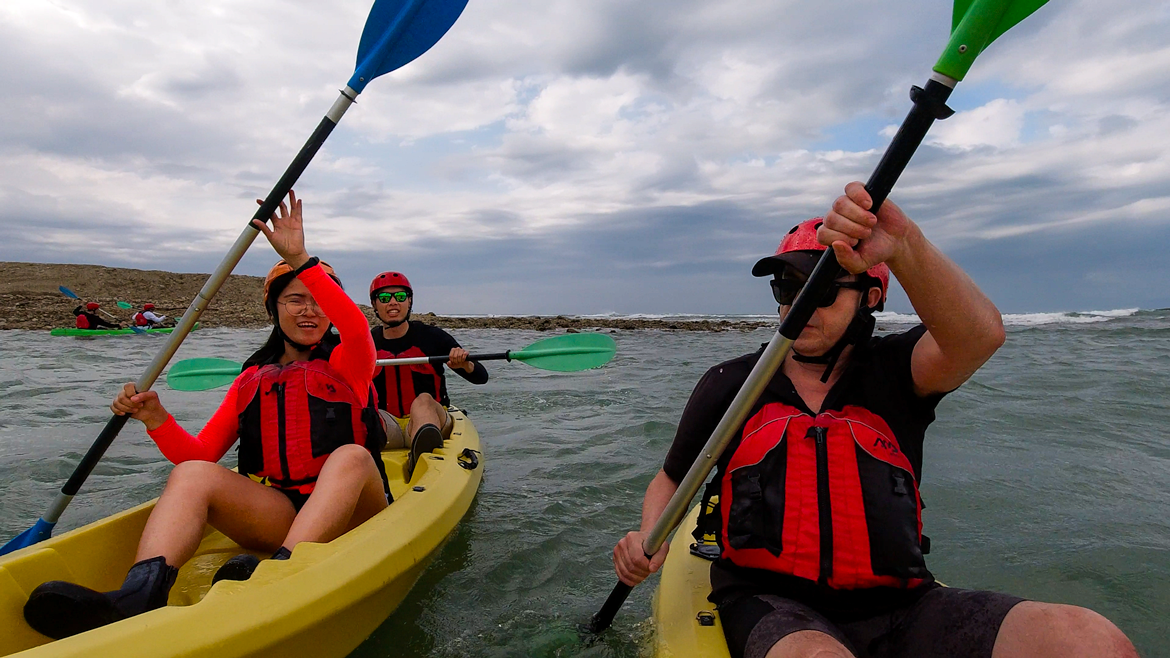
Heading back to the center of the bay, the instructor shouted “Let’s turn right, and ride some waves!” “What? Really? Alright, let’s do this!” Like a surfer on a board we headed straight into the swell, turned around and waited for the adrenaline-inducing push towards the shore. We did this a few times, trying to catch bigger waves each time. But then the inevitable happened. Not able to turn fast enough, one big breaker hit the side of our kayak, turning it upside down. Wearing a life vest and having tested the water temperature already there was nothing to worry about, though. I also soon realized that the water in the bay is in fact very shallow, which allowed us to simply and safely walk through the water to the nearest rocks where we boarded the kayak again. While I love the forests and nature, I have to admit that those were perhaps the most exciting moments of the whole trip.
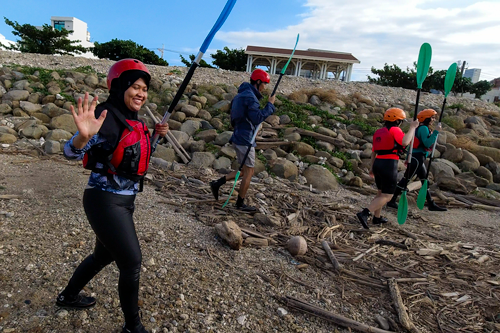
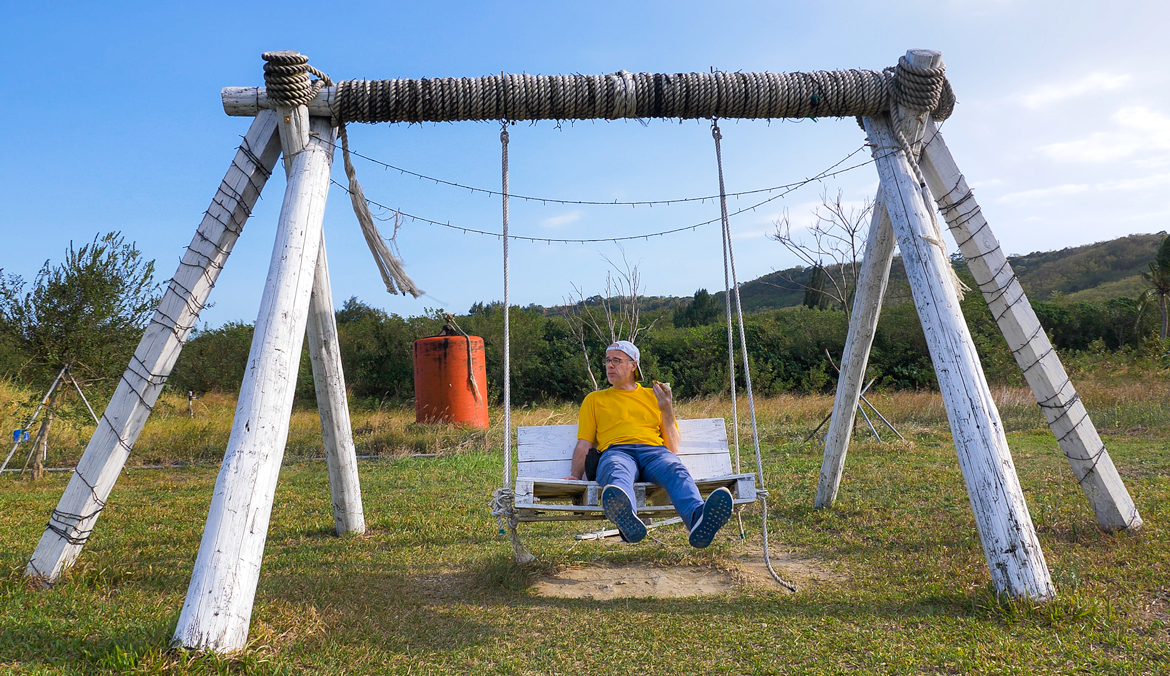
Sea kayaking requires quite a bit of energy, so we couldn’t wait to munch down the delicious hamburgers already prepared for us when returning to the kayaking base. The yummy food is prepared inside a converted bus, named Me Time.
Kayaking at Fulong on the Northeast Coast
Staying by the Sea in Kenting
If you are looking for a good-quality beach-side resort hotel in Taiwan, look no further than the Chateau Beach Resort in Kenting. The biggest advantage of this hotel is its proximity to a fine-sand beach, just a one-minute walk from the sea-facing guestrooms (making it three out of three hotels with a superb location on this trip!). The beach, exclusively used by the hotel, is spotless clean with life guards keeping an eye on beach goers; there are facilities and equipment provided by the hotel, a large pool area for those times when swimming in the ocean is not possible, and a wide range of indoor facilities to keep you busy during your stay. I did enjoy a long pre-breakfast beach walk and relaxed a bit on the wooden lounge chairs, nicely placed under shady palm trees with the beach in full sight. Vacation vibes!
Book a room here.


Sheding Night Excursion
Kenting is best known for its beaches and its large number of restaurants, hotels, and shops catering to the sun and water fun seeking crowds, but there is much more in store for visitors with a wider set of interests. Since our main aim of visiting Kenting was experiencing its natural environment we turned away from the waves and headed to the tropical forest. Kenting National Park is home to 15 species of mammals, 316 species of birds, 59 species reptiles, and 216 species of butterflies. First we did a nighttime eco-excursion tour in Sheding Nature Park, led by local guide, Mr. Wu Fu-sheng. I have never seen a veteran naturalist getting more excited than Mr. Wu when spotting wildlife. He was without doubt the most excited person on the tour, and he must have seen the reptiles and insects of this park a thousand times.
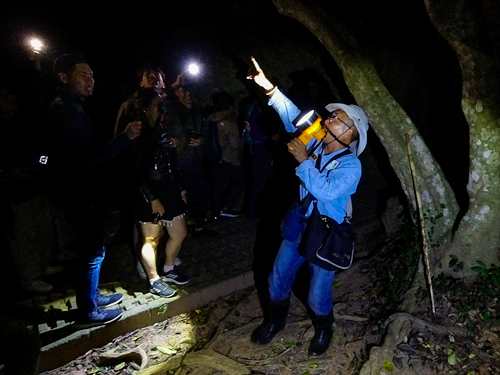
In a short period of time we saw two snakes (a greater green snake and a Taiwan habu), a number of really pretty butterflies (golden birdwing and paper kite), an amazing giant stick insect, and numerous interesting plants (including the very tropical-looking fish poison tree). Someone even spotted a sika deer in the dark, though it quickly disappeared, most likely because of the many flashlights pointed its way.
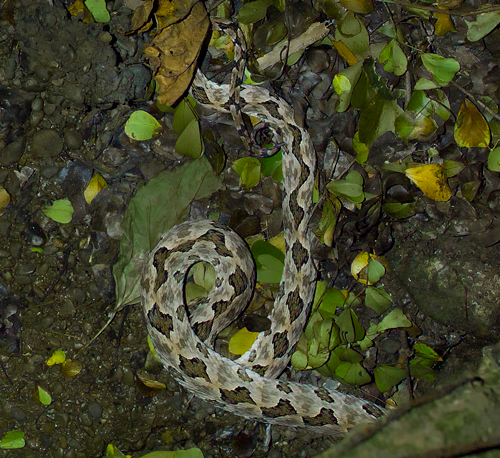
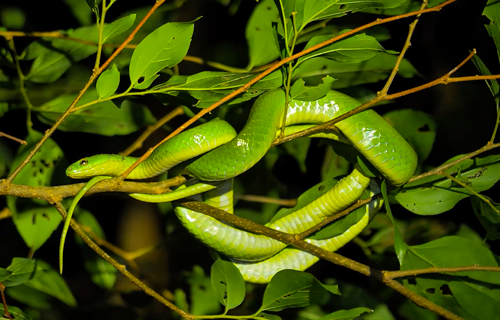
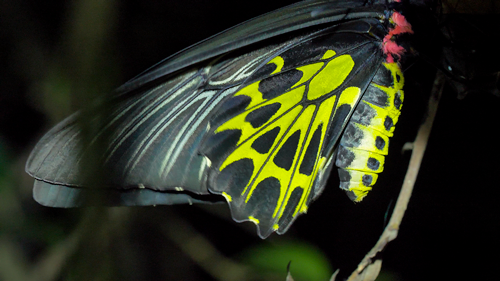
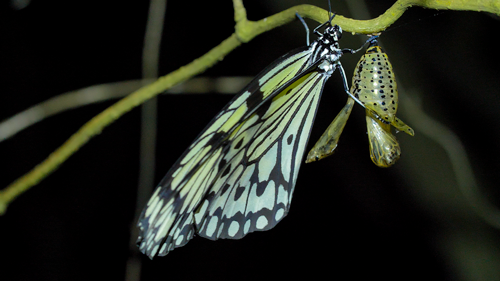
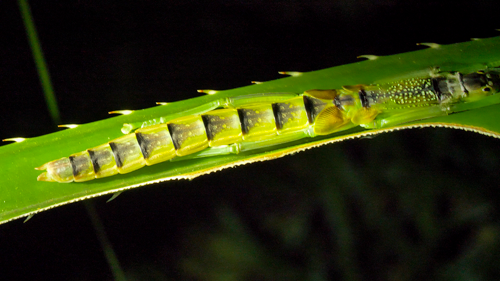
Note: If you don’t know what a sika deer looks like, take out a NT$500 bill; you’ll see the deer on the backside.
Tree Climbing
The final day of our Alishan-Kenting adventure had more action and natural/scenic beauty in store for us. I have never climbed trees using ropes, so I was happy to learn about it during a tree-climbing session under a giant century-old autumn maple tree inside the Kenting National Forest Recreation Area. Knowing next to nothing about knots it took me a while to figure out what to do. A big thank you to the patient instructors led by Tsai Kuo-chung and Ye Ling-wei.
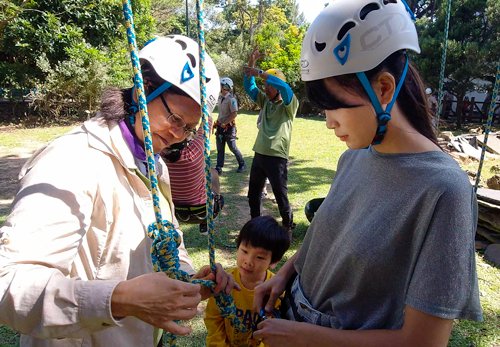
The tree-climbing turned out to be easier than it initially looked and we soon were hanging about 10 meters above the ground, yelling for joy and snapping pictures of each other. While this was mostly fun, we also learned that tree-climbing is an important part of inspecting trees, which in turn is an important part of conserving and preserving the natural treasures of this and other nature parks around Taiwan.


Tropical Forest Tour
After the eco-tour the night before, our final activity of this memorable trip was walking through tropical forest again, this time during the day.

What amazed me the most was how large trees (strangler figs) are able to grow on top of huge coral rocks, their long roots finding ways around the rocks to reach the ground. One of the volunteer guides accompanying us explained to me how the coral rocks actually help the trees by protecting them from the strong winds that often sweep the Hengchun Peninsula. During our forest walk we also saw the well-known looking glass tree, which has impressive buttress roots, a sika deer grazing in the bushes, and two families of very agile Formosan macaques.

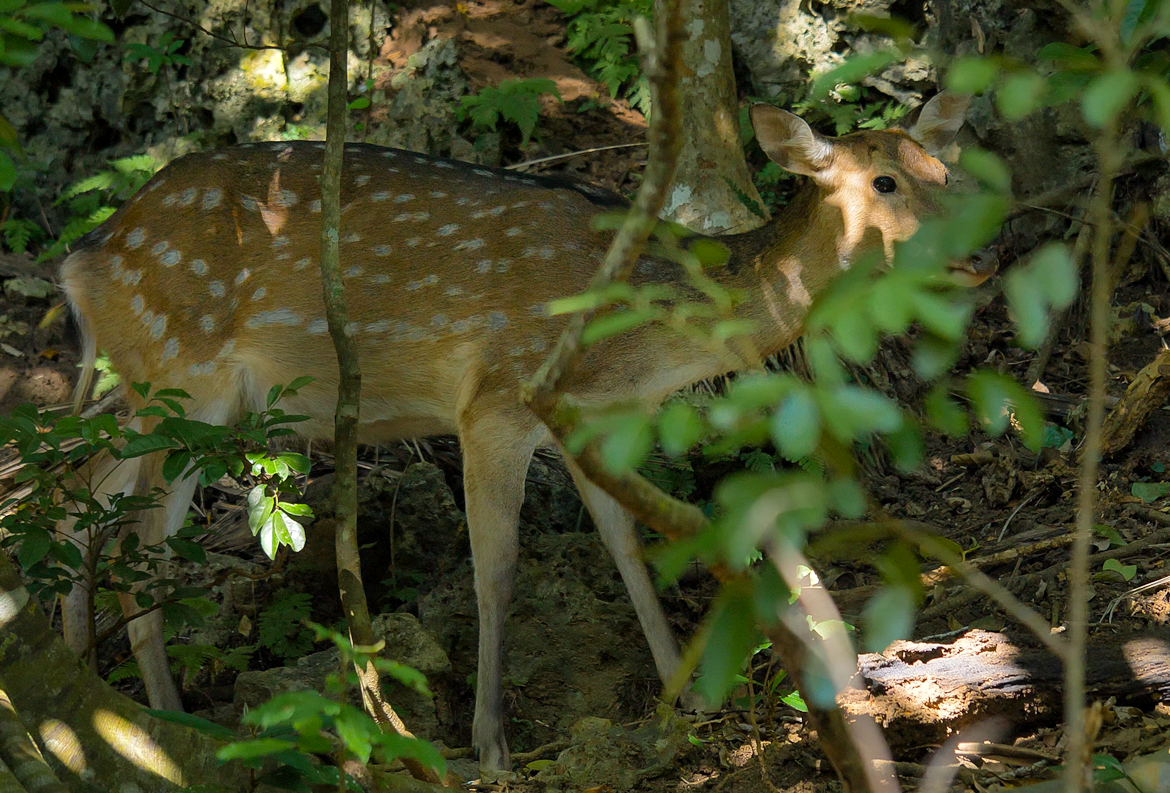
The final highlight of this forest tour and of the whole four-day journey was the Fairy Cave. Not even knowing that there was a cave in the park before the trip, I was wowed by its beauty. It’s not particularly large, but I liked how the simple warm lighting perfectly accentuated the interestingly shaped walls of this narrow cave. And what was that black spot on the wall, close to the cave’s exit? A bat! In arm’s reach. Never seen a bat that close in my whole life!
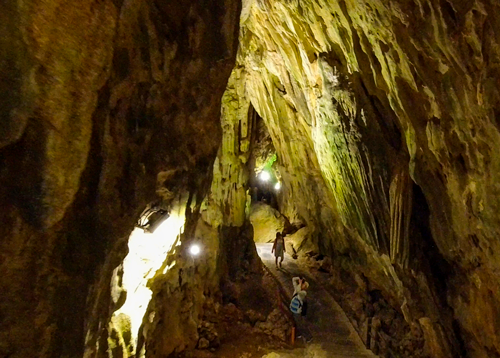
Final Words
And that concluded our fun-filled 4-day trip to the Alishan and Kenting national forest recreation areas in southern Taiwan. I knew before the trip that it would be a great one, but I didn’t expect it to be that great. We learned a lot of new things from the knowledgeable, passionate and patient, and always friendly guides who showed us around. This trip has once again shown me why Taiwan is such a fascinating place to visit. One day you watch the sunrise and sip tea in the temperate zone forest of the high mountains, the next you are capsizing a kayak off the coast of the island’s tropical south and are rewarded with a big delicious hamburger afterwards. The abundance of natural habitats and the variety of flora and fauna is astonishing. The ways to have outdoor fun are endless. The friendliness of the people is humbling.
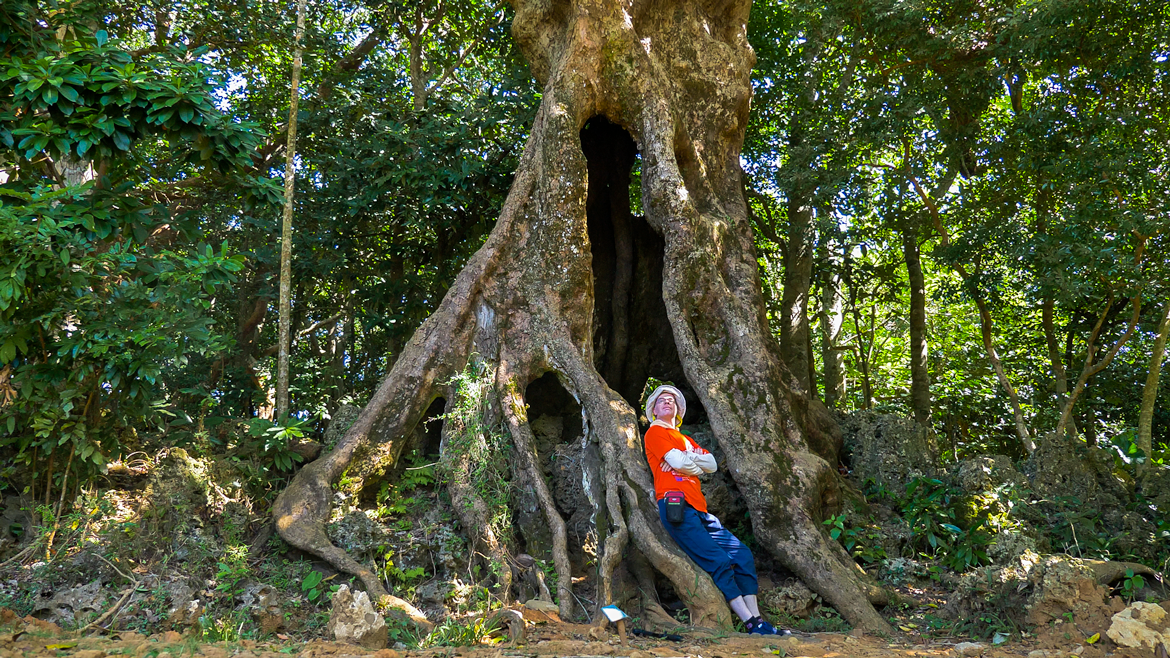
Can’t wait to do a trip like that again soon!
A big Thanks to the Forestry Bureau for making this trip possible. A central-government agency the bureau is part of the Council of Agriculture, Executive Yuan, and is in charge of managing national forest recreation areas around Taiwan, including Alishan and Kenting, as well as the Alishan Forest Railway. The agency’s self-stated mission is to protect the forest ecosystem and conserve natural resources in order to build a safe, ecological, high-quality homeland. Thanks to all the guides who patiently introduced to us the many places we visited on this trip!
For more stories about this trip visit the Hidden Treasure of Asia website. There were a total of 10 foreign participants, each writing and sharing his/her experience. Apart from this writer also read stories by the following contributors (links will be provided as soon as the articles are posted online):
Adam Phan The Anh from Vietnam (check out Adam’s Youtube channel Thầy Giáo Anh)
Ami Barnes from England (check out Ami’s blog Taiwan Trails and Tales)
Flavio Noriega from Peru (follow Flavio on Instagram flavio.noriega)
Francesca Chang from the US (follow Francesca on Instagram attorney_on_a_journey)
Eric Chen and Ian Lee from the US (check out their Youtube channel The Dodo Men)
Raudlah Hawin Ayani from Indonesia (follow Raudlah on Instagram auudaa)
Rick Charette from Canada (find articles by Rick on Taiwan Everything here)
Shiela Mecha Cabahug from the Philippines (follow Shiela on Facebook shilelamc)
About the author

Twelli
Long-time resident of Taiwan, Twelli likes to go on trips around Taiwan and make videos.











